Claw and leg lesions in sows may cause lameness, and have detrimental effects on animal welfare. In the European Welfare Quality® protocol, lameness is one of the animal-based measures to assess animal welfare (Welfare Quality® consortium, 2009). Besides welfare problems, economic losses due to lameness are also an important concern for pig producers. A high prevalence of sows with claw and leg problems means more labour for the farmer and increases the costs of medical treatment. Furthermore, locomotor disorders are the second largest reason for the (early) culling of sows, resulting in a lower average longevity of sows in a pig herd. Severely affected lame sows must be euthanized which implies a loss of slaughter revenue, and extra costs for euthanasia and destruction. Removal of sows from the herd before they attain their optimal production age (Ritter et al., 1999) results in an imbalanced parity distribution with a shift to young sows, decreasing the mean litter size and the number of pigs weaned per sow per year (D'Allaire et al., 1987; Engblom et al., 2007). Although the direct impact of lameness on productivity has already been investigated in finisher pigs (Johansen et al., 2004; Jensen et al., 2007), there is still discussion about the direct effect of lameness on (re)production in sows (Penny, 1980; Kroneman et al., 1993a; Heinonen et al., 2006). Finally, claw lesions may serve as possible ports of entry for infections. These infections may ascend and spread throughout the body, affecting joints and causing abscesses in other tissues, increasing the chance of condemnation of carcasses at the slaughterhouse.
Lameness as well as claw and leg lesions are very common in sows. In several studies, a very high percentage (more than 90%) of sows were reported to have claw lesions (Gjein and Larssen, 1995a,b; Anil et al., 2007), while generally a mean of 10% of the sows have been described to be lame (Gjein and Larssen, 1995c; Holmgren et al., 2000; Heinonen et al., 2002, 2006). The prevalence of lameness, however, seems to vary greatly from herd to herd and in some studies can reach up to 28% of all sows (Heinonen et al., 2006). Many factors may influence the development of locomotor disorders in sows. However, feed, housing (mainly floor properties) (Kroneman et al., 1993b; Anil et al., 2007), and rearing strategy are considered as especially important risk factors.
From a welfare point of view, group housing of gestating sows will become mandatory in the European Union in 2013 (91/630/EEC). Different types of group housing are possible, e.g., free access stalls, pens with electronic sow feeders, trickle feeding, floor feeding and individual feed stalls. Despite the advantages for animal welfare (Lynch et al., 2000; Anil et al., 2003) group housing may also have disadvantages such as higher hierarchical interactions and even aggression between sows, as well as more leg and claw disorders (Kroneman et al., 1993a; Gjein and Larssen, 1995a,b). Yet, studies in which different types of group housing have been compared with regard to lameness and claw health are missing from the literature. In addition, in Belgium almost no data are available on the prevalence of claw lesions and lameness, and on risk factors influencing these conditions. Therefore, the aim of the present study was first to investigate the prevalence of lameness and claw lesions in sows, kept in two different types of group housing in Belgian pig herds, and secondly, to analyze sow-related risk factors associated with lameness and claw lesions.
MATERIAL AND METHODS
Study population
The present study was carried out on eight Belgian pig herds with loose housing of gestating sows. The following criteria were used to select the herds: presence of breeding sows, use of one of the two investigated types of group housing for gestating sows and motivation of the farmer to participate in the study. In four herds, sows were housed in pens with electronic sow feeders (dynamic groups), the other four herds used free access stalls (static groups). A recent study revealed that free access stalls and pens with electronic sow feeders will be used most in the future in Flanders (Tuyttens et al., 2007). The presence or absence of leg or claw problems was not taken into account when selecting herds. The general characteristics of the eight investigated herds are presented in Table 1. A total of 421 sows, belonging to one or two successive farrowing batches within each herd, were included in the study.
Table 1. General characteristics of the eight investigated herds (1–8)
Study design
From every herd, one or two batches of sows were included in the study. Every batch was visited twice: firstly, one week before parturition when the sows were housed in the gestation unit and a second time, within three days after parturition when the sows were housed in the farrowing crates. During the first herd visit, a questionnaire, including potential risk factors for lameness and claw lesions in sows (Kroneman et al., 1993b; Gjein and Larssen, 1995a,b; Heinonen et al., 2006; Anil et al., 2007), was completed. The information pertained to feed, housing conditions (physical properties of the floor and floor space allowance) and culling strategy as well as information about parity (1, 2, 3–5, > 5) and breed of each sow (Table 2). General information about the herd, feed and culling strategy was gained from the farmer. Feed samples (gestation and lactation feed) were taken and evaluated by proximate analysis (Thiex, 2002). Information about housing conditions was recorded through visual judgement and slat/slot width and floor space allowance were measured.
Assessment of lameness and scoring of claw lesions
During the first herd visit lameness was also assessed. Sows were made to walk a short distance – approximately five metres, once or twice, until a clear view of the locomotion within the gestation stable could be obtained. While walking, their gait was visually scored through checking for weightbearing difficulty on one or more limbs. Sows were categorized as either lame or non-lame. A similar procedure to investigate lameness was used by Anil et al. (2007).
Table 2. Herd related information collected by use of a questionnaire

During the second herd visit, claw lesions of the sows were scored in the farrowing crates shortly after parturition. At that time, sows tend to lay down more often which makes scoring, especially of the heel region, easier. If sows were standing, all claw lesions could be examined except for the heel lesions. As soon as these sows lay down, also the heel region was scored. The scoring of claw lesions was carried out by using a standardized scoring system developed in the Netherlands (Hoofs et al., 2006), with some modifications. Five claw regions were evaluated using a photomap depicting the severity levels of the lesions (Table 3, Figure 1). Lesions included cracks in the wall region, cracks or overgrowths of the heel region, overgrown or torn (dew-) claws and skin lesions. Scores range from 1 (no lesions) to 4 (severe lesions). Unlike the Dutch method, lateral and medial claws were scored separately (Simmins and Brooks, 1988; Kroneman et al., 1993a,b; Anil et al., 2007). As claw lesions are present more often on the hind legs (Kroneman et al., 1993a; Jorgensen, 2000), only the claws of the hind legs were scored.
A "total score" for each sow per region was obtained by adding the scores of the four claws for each region (five in total). Hence, a total score could vary between 4 and 16. A "global score" was calculated by adding the separate "total scores" of each region and this could vary between 20 and 80.
Table 3. Explanation of the modified, standardized claw lesion score system ("zeugenklauwencheck") that was used in this study
Assessment of lameness as well as scoring of claw lesions in all sows was done by the same person for all eight participating herds.
Statistical analysis
Logistic regression analysis, with the herd as a random effect to correct for the clustering of sows within a herd, was used to evaluate potential risk factors associated with lameness (yes/no variable). The presence of lameness was handled as a dependent variable, while the different risk factors (breed, parity, claw lesion scores and housing system) were treated as independent variables. Breed and parity were regarded as classified effects (six categories for breed and four categories for parity). Claw lesion scores were considered as a continuous effect.
The individual claw lesion scores and the total and global scores were evaluated using linear mixed model analysis with breed, parity and lameness as fixed effects and herd as a random effect. Bonferroni adjustment was used in the case of multiple comparisons. A paired t-test was conducted to test for a possible statistically significant difference in the total score of the medial and lateral claw of the hind legs within each sow. Differences in the severity of claw lesion scores and prevalence of lameness between the two types of group housing were evaluated using monofactorial analysis of variance (ANOVA) and logistic regression analysis, respectively. As only eight herds were included in this study, only sow-related factors and, as an exception housing system, were evaluated as possible risk factors. Herd-related information as well as feed analysis were collected and used to explain specific results of herds as part of the discussion. All analyses, except the logistical regression analysis of lameness, were performed using SPSS 16.00 software (SPSS Inc., Illinois, 2008). Risk factor analysis for the 0/1-variable lameness was performed using MLwiN 2.02 (Centre for Multilevel Modeling, Bristol, UK). A P value < 0.05 was considered significant and a 2-sided test was used in each analysis.
Figure 1. Presentation of score 1–3 for dew claw length as used in the Dutch scoring system. Score 4, torn dew claw, is not presented in the figure
RESULTS
Lameness
From the 421 sows, the mean percentage of lame sows was 9.7% at the end of gestation (min. 2.4% – max. 23.1%). No significant differences in prevalence of lameness could be found between the two types of group housing or the different sow breeds. The claw lesion score was not significantly different between lame and non-lame sows. Parity tended to be associated with lameness (P = 0.06) (Table 4). Compared to first parity sows, the risk for lameness was slightly higher for parity group 2 (OR = 1.15) but lower for parity groups 3 (OR = 0.54) and 4 (OR = 0.24).
Table 4. Logistic regression analysis, with herd and sow as random effects, was used to evaluate potential risk factors (breed, parity, claw lesion score and housing system) associated with lameness (yes/no variable) among the 421 sows
Claw lesions
Almost every sow had one or more claw lesions. Only 0.95% of all sows showed no lesions. With regard to the different parts of the claws, the percentages of sows with long claws, long dew claws and lesions on the heel region, wall region and the skin were 38%, 39%, 93%, 52% and 37%, respectively. The total scores of all 421 sows are presented in Table 5. The highest total scores, i.e., most severe lesions, were found for the heel region and the length of dew claws.
Comparison between the lateral and the medial claw showed, with high significance (P < 0.01), that the total score for each of the five parameters as well as the global score was higher for the lateral claws (Table 5). This difference was most apparent with regard to lesions at the level of the heel region (mean difference of 2.7).
Between lame and non-lame sows, only the mean total score for dew claw length differed significantly. Lame sows had higher mean total scores and therefore longer, to even torn, dew claws compared to non-lame sows. As for lameness, the effect of breed as a risk factor for claw lesions was not observed.
Parity significantly influenced claw lesion score. The older the sows, the higher the global score and more specifically, the higher the risk for long (dew) claws and wall cracks (Figure 2). No association could be shown between parity and the total score for the other two parameters (skin and heel lesions).
Figure 2. Graphical representation of the association between parity and the global score of claw lesions

The mean total and global score for each herd is shown in Table 6. Within each herd, also the highest mean total score was found for the heel region with herd 1 having the worst scoring for this parameter (mean total score of 9.2 and standard deviation of 2.8). Long claws (toes) were primarily a problem in herd 5 whereas long and even torn dew claws represented a larger problem in herd 6. The worst mean total score for wall horn quality (presence of cracks) was seen in herd seven. Regarding the skin above the claws, all herds showed relatively low mean total scores (min. 4.2(0.5), max. 5.5(1.9)). Between herds, the mean global score varied between 26.2 (3.9) and 30.7 (5.2) with the highest mean global score for herd 3 and the lowest for herd 8. Sows housed in free access stalls had a lower mean total score for each of the five assessed parameters (P > 0.05), except for the heel region for which the mean total score was better in the group housed with electronic sow feeders (Table 5).
Table 5. Mean total score of each region and mean global score presented separately for herds with free access stalls and herds that used pens with electronic sow feeders, also scores presented separately for the lateral and medial claw and, in the middle, an overview of the 421 assessed sows
DISCUSSION
Lameness
The present study showed that 9.7% of sows housed in two different types of group housing, namely free access stalls and pens with electronic sow feeders, showed lameness. Similar findings for lameness among breeding sows were observed in Finland (Heinonen et al., 2006) and Norway (Gjein and Larssen, 1995c). Heinonen et al. (2006) found a mean prevalence of 8.8% while in the study of Gjein and Larssen (1995c) 13.1% of the loose-housed dry sows showed hind leg lameness. Several studies have already showed a higher prevalence of lameness in sows kept in group housing compared to individual housing (Kroneman et al., 1993a; Gjein and Larssen, 1995c; Anil et al., 2005). A large variation was found between the eight selected herds. This is consistent with the findings of Gjein and Larssen (1995c), Holmgren et al. (2000), Heinonen et al (2006) and Geverink et al. (2009), and may be due to the fact that a large number of conceivable risk factors for lameness exist and may differ between herds. No significant difference in the prevalence of lame sows between the two types of group housing was found although there was found to be a high variation between herds. This supports the theory that additional factors will influence the development of lameness and also implies that when changing to loose housing for gestating sows, the choice between these two types of group housing will be of minor importance regarding locomotor disorders.
Table 6. Mean total score of each evaluated region of the claw and mean global score presented for the investigated sows in each of the eight herds
Breed could not be identified as a risk factor for lameness in the present study. Conversely, Heinonen et al. (2006) showed that Yorkshire sows had 2.7 times higher odds of being lame compared to Landrace sows. In this Finnish study 292 Landrace sows, 78 Yorkshire sows and 273 Crossbreds were used. The fact that no pure breeds but only different commercial crossbreds are compared in our study can be a possible explanation for why no significant breed differences could be found.
The occurrence of lameness tended to be associated with parity. Younger sows (first or second parity) were at a higher risk compared to older sows (parity 3 or higher). A lower risk for lameness in older sows was also found in some other studies (Gjein and Larssen, 1995c; Heinonen et al., 2006). However, this trend of decreasing risk with ageing may be the result of a strict culling strategy.
Claw lesions
The heel and wall horn region were the most affected parts of the claw, corresponding with the results from studies in other countries (Gjein and Larssen, 1995a; Kirk et al., 2005; Anil et al., 2007). Given the close contact between the floor and the heel region, poor hygiene and floor quality can severely impact the heel region and favour the development of overgrowth and cracks in the heel area. The severity of lesions was worst in the heel region and dew claws. These results suggest that cracks in the wall, although commonly present, have less clinical importance compared to lesions at the dew claws, which are usually rare but clinically very important. It remains unknown why in some herds dew claws are of the proper length whereas in other herds they are extremely long or even torn. A few hypotheses have been proposed although none of them has yet been proven scientifically. In contrast to wild boars, dew claws do not touch the ground in domesticated pigs which excludes the problem of wear and tear as a plausible explanation (Geyer, 1979). Feed composition is thought to have an influence albeit the interaction of food components and (severe) elongated dew claws is still unknown (Lamers, 2006). In the present study, none of the herds showed a feed composition distinct from normal values (NRC, 1998) and only minor differences in feed composition between herds were observed (results not shown). Nevertheless, herd 6 had a huge problem with long and torn dew claws whereas in herd 8 dew claws showed an acceptable length. The fact that sows were housed on new concrete floors without first liming or cleaning it with water could be a possible reason for the severe heel lesions, especially overgrowth, in herd 1.
Lesion scores were significantly higher for the lateral (global sore: 16.4) than for the medial claws (global score: 11.9). A similar difference was observed in other studies (Gjein and Larssen, 1995a; Jorgensen, 2000; Anil et al., 2007). This can be explained based on anatomical and biomechanical aspects of the pig's claw. The four lateral claws together carry 78% of the total body weight (Webb, 1984). Therefore, lateral claws are loaded and stressed much more compared to the medial claws. In addition, the surface of the lateral claws is larger. This may, on one hand, lower the pressure but on the other hand, makes it more prone to lesions. The dissimilarity between lateral and medial claws is determined by genetic factors as well as influenced by housing conditions (Kroneman et al, 1992).
Between the two types of group housing, no significant distinction in claw lesion score could be found. Notwithstanding the results of Anil et al. (2007), in the present study, sows housed in free access stalls demonstrated higher scores for the heel region compared to sows housed in pens with electronic sow feeders. Herd two suffered from heel overgrowth and cracks probably due to the new concrete floor. As this herd with specific high scores for the heel region used free access stalls, the mean score for the heel region in free access stalls may be biased.
Only the score for dew claw length differed significantly between lame and non-lame sows, with a higher score for lame sows (Table 5). Sows with long dew claws can get stuck between the slats of the floor with a high risk of tearing the dew claws. When dew claws are ripped off, the well innervated corium will be exposed which can be considered as very painful for the animal. In the Dutch scoring system, torn dew claws were given the highest score (score 4). Older sows showed a higher global score and a higher total score for (dew) claw length and wall cracks. This agrees with the results of Dewey et al. (1993).
Older sows, especially those between the third and the fifth parity, are characterized by high reproductive performance. Hence, these sows also have high nutritional demands, especially during the last month of gestation and during lactation (Tubbs, 1988). As a result, the (temporary) insufficient supply of nutrients (vitamins, minerals, amino acids, etc.) in feed can occur which can result in, among other things, poor horn quality. This reasoning has already borne up to scientific scrutiny for young sows in the case of biotine (Simmins and Brooks, 1983, 1988). Young sows are still growing and therefore may have high nutritional demands as well. However, their body weight is lower. As the animals age, their body weight and as result of this also the load on the four claws, increases. The trend of long (dew) claws in older sows cannot be justified based on a difference in horn growth as growth decreases with increasing age (Geyer, 1979). An abnormal gait or bone deformation caused by pain or due to a congenital malformation of the leg can trigger an unequal load and wear of the claws and may end up in overlong or deformed claws.
CONCLUSIONS
Lameness and claw lesions are commonly found in group-housed sows in Belgian herds. No significant difference in lameness could be found between the two types of group housing, implying that a choice between these types of group housing can be made without jeopardizing the claw health and welfare of the animals. The risk for lameness was lower while the risk for claw lesions was higher in older sows. This indicates that, especially in older sows, lameness can also be caused by reasons other than claw lesions. In addition, a balanced parity distribution of sows will be important for productivity reasons as well as to avoid problems with locomotor disorders. The high percentage of heel cracks and overgrowth as well as the elusiveness regarding the reasons for long dew claws means that further research on ways to control or prevent claw lesions in group-housed sows is needed.
Acknowledgements
The authors also wish to thank the farmers from Flanders for their co-operation in this study.
REFERENCES
Anil L, Bhend KMG, Baidoo SK, Morrison R, Deen J (2003): Comparison of injuries in sows housed in gestation stalls versus group pens with electronic sow feeders. Journal of the American Veterinary Medical Association 223, 1334–1338.
Anil SS, Anil L, Deen J (2005): Evaluation of patterns of removal and associations among culling because of lameness and sow productivity traits in swine breeding herds. Journal of the American Veterinary Medical Association 226, 956–961.
Anil SS, Anil L, Deen J, Baidoo SK, Walker RD (2007): Factors associated with claw lesions in gestating sows. Journal of Swine Health and Production 15, 78–83.
D'Allaire S, Stein TE, Leman AD (1987): Culling patterns in selected Minnesota swine breeding herds. Canadian Journal of Veterinary Research 51, 506–512.
Dewey CE, Friendship RM, Wilson MR (1993): Clinical and postmortem examination of sows culled for lameness. Canadian Veterinary Journal 34, 555–556.
Engblom L, Lundeheim N, Dalin A-M, Andersson K (2007): Sow removal in Swedish commercial herds. Livestock Science 106, 76–86.
Geverink N, Tuyttens F, Geenen H, Geers R (eds.) (2009): Group housing of sows: consequences for welfare, health status and environment (in Dutch). FOD Volksgezondheid, Veiligheid van de Voedselketen en Leefmilieu, Belgium. 171 pp.
Geyer H (1979): Morphology an growth of the pig claw. Principles for selection of stable flooring and claw pathology (in German). [Dissertation.] University of Zurich; 111 pp.
Gjein H, Larssen RB (1995a): Housing of pregnant sows in loose and confined systems – a field study. 2. Claw lesions: morphology, prevalence, location and relation to age. Acta Veterinaria Scandinavica 36, 433–442.
Gjein H, Larssen RB (1995b): Housing of pregnant sows in loose and confined systems – a field study. 3. The impact of housing factors on claw lesions. Acta Veterinaria Scandinavica 36, 443–450.
Gjein H, Larssen RB (1995c): The effect of claw lesions and claw infections on lameness in loose housing of pregnant sows. Acta Veterinaria Scandinavica 36, 451–459.
Heinonen M, Oravainen J, Tast A, Peltoniemi OAT (2002): Lameness and fertility in sows and gilts – a pilot study. Reproduction in Domestic Animals 37, 236.
Heinonen M, Oravainen J, Orro T, Seppa-Lassila L, Ala- Kurikka E, Virolainen J, Tast A, Peltoniemi OAT (2006): Lameness and fertility of sows and gilts in randomly selected loose-housed herds in Finland. Veterinary Record 159, 383–387.
Holmgren N, Eliasson-Selling L, Lundeheim N (2000): Claw and leg injuries in group-housed dry sows. In: Proceedings of the 16th Congress of the International Pig Veterinary Society, Melbourne, Australia, 352.
Hoofs AIJ (2006): "The eugenklauwencheck" (in Dutch). Wageningen UR, The Netherlands. http://www.verantwoordeveehouderij. nl/klauwencheck
Jensen TB, Baadsgaard NP, Houe H, Toft N, Ostergaard S (2007): The effect of lameness treatments and treatments for other health disorders on the weight gain and feed conversion in boars at a Danish test station. Livestock Science 112, 34–42.
Johansen M, Alban L, Kjærsgard HD, Bækbo P (2004): Factors associated with suckling piglet average daily gain. Preventive Veterinary Medicine 63, 91–102.
Jorgenson B (2000): Osteochondrosis/Osteoarthrosis and claw disorders in sows, associated with leg weakness. Acta Veterinaria Scandinavica 41, 123–138.
Kirk RK, Svensmark B, Ellegaard LP, Jensen HE (2005): Locomotive disorders associated with sow mortality in Danish pig herds. Journal of Veterinary Medicine A 52, 423–428.
Kroneman A, Vellenga L, Vermeer HM, van der Wilt FJ (1992): Claw health in pigs (in Dutch). Research Institute for Pig Husbandry. Report P 1.78. Wageningen UR. 32 pp.
Kroneman A, Vellenga L, van der Wilt FJ, Vermeer HM (1993a): Field research on veterinary problems in grouphoused sows – a survey of lameness. Journal of Veterinary Medicine A 40, 704–712.
Kroneman A, Vellenga L, van der Wilt FJ, Vermeer HM (1993b): Review of health problems in group-housed sows, with special emphasis on lameness. Veterinary Quarterly 15, 26–29.
Lamers J (2006): "The Zeugenklauwen-check" brings problems into perspective (in Dutch). Varkens 34–36.
Lynch PB, Boyle L, Leonard F, Terngy A, Brophy P (2000): Studies on housing of pregnant sows in groups and individually. Teagasc, Dublin, Report Project No. 4563, 24 pp. http://www.teagasc.ie/research/reports/pigs/ 4563/eopr-4563.pdf
NRC (1998): Minerals and Vitamins. In: Nutrient Requirements of Swine. 10th ed. Committee on Animal Nutrition, Subcommittee on Swine Nutrition, NW, Washington, D.C. p.47–90.
Penny RHC (1980): Locomotor dysfunction causing reproductive failure. In: Morrow DA (ed.): Current Therapy in Theriogenology. 1st ed. WB Saunders, Philadelphia. 1042–1045.
Ritter LA, Xue J, Dial GD, Morrison RB, Marsh WE (1999): Prevalence of lesions and body condition scores among female swine at slaughter. Journal of the American Veterinary Medical Association 214, 525–528.
Simmins PH, Brooks PH (1983): Supplementary biotin for sows: effect on reproductive characteristics. Veterinary Record 112, 425.
Simmins PH, Brooks PH (1988): Supplementary biotin for sows: effect on claw integrity. Veterinary Record 122, 431–435.
Thiex N (2002): Committee on feeds, fertilizers, and related agricultural topics. Feeds. Journal of the Association of Official Analytical Chemists International 85, 270–273.
Tubbs RC (1988): Lameness in sows: solving a preventable problem. Veterinary Medicine 83, 610–616.
Tuyttens FAM, Struelens E, Van Gansbeke S, Ampe B (2007): Factors influencing farmers' responses to welfare legislation: A case study of gestation sow housing in Flanders (Belgium). Livestock Science 116, 289–299.
Webb NG (1984): Compressive stresses on, and the strength of, the inner and outer digits of pigs feet and the implications for injury and floor design. Journal of Agriculture Engineering Resource 30, 71–80.
Welfare Quality® (2009): Welfare Quality® Assessment Protocol for Pigs (sows and piglets, growing and finishing pigs). Welfare Quality Consortium, Lelystad, The Netherlands. 122 pp.
This article was originally published in Veterinarni Medicina, 56, 2011 (3): 101–109. This research was supported by “Veepeiler Varken” Dierengezondheidszorg Vlaanderen vzw, Torhout, Belgium. Engormix.com thanks for this huge contribution.
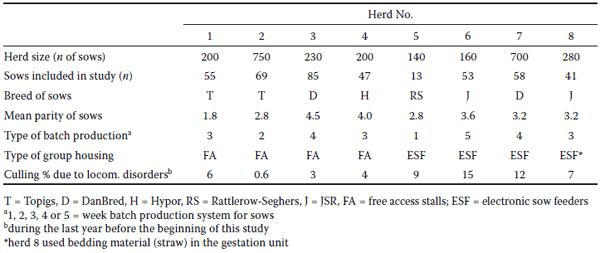

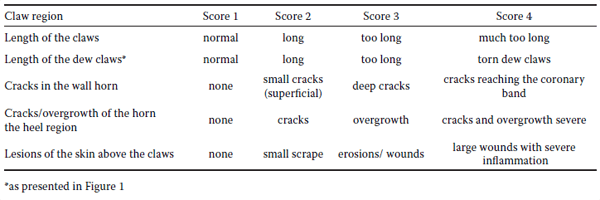
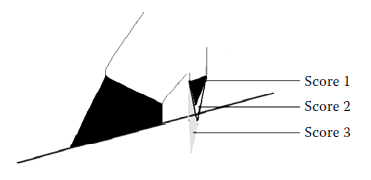
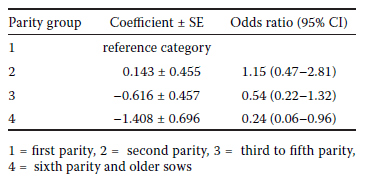


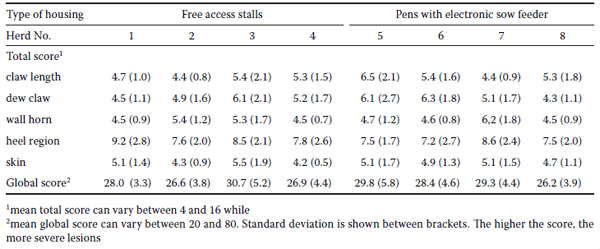







.jpg&w=3840&q=75)